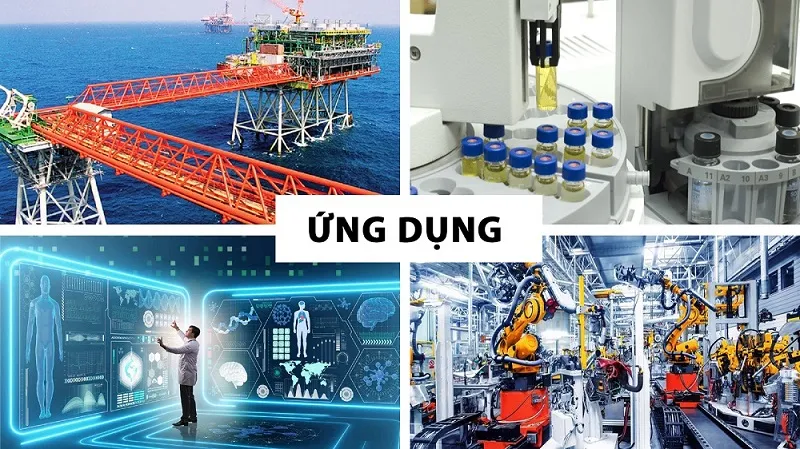What is a pressure sensor?
Pressure sensor is a device used to measure the pressure level of gases or liquids, then convert the measured value into an electrical signal for display, monitoring, or control in technical systems.
This device plays a vital role in various fields such as industrial manufacturing, HVAC systems, healthcare, automotive, and automation systems. Accurate pressure measurement enhances operational safety while optimizing system efficiency and stability.
Operating principle of pressure sensors
Pressure sensors work by converting pressure into an electrical signal. When pressure is applied to the sensing element, it causes mechanical deformation or changes in electrical properties such as resistance, capacitance, or piezoelectricity, which is then converted into an output signal.
Common working principles include:
- Electromechanical sensors: Use mechanical deformation of a diaphragm or Bourdon tube.
- Electronic pressure sensors: Use piezoelectric materials to generate voltage under pressure.
- Photoelectric sensors: Measure pressure based on light modulation.
- Capacitive sensors: Pressure changes the gap between two electrodes, altering capacitance.

Pressure sensor structure
Typical components of a pressure sensor:
- Sensing element: Receives pressure and converts it into a mechanical signal.
- Signal converter: Converts mechanical signal into an electrical signal.
- Signal processing unit: Filters, amplifies, and outputs standard signals (e.g., 4–20 mA, 0–10 V).
- Display unit: Shows readings via LCD, LED, or analog dial.
- Protective housing: Shields from dust, water, chemicals, and impact for reliable performance in harsh environments.
Types of pressure sensors
By pressure measurement type
- Absolute pressure sensor: Measures pressure relative to a perfect vacuum (0 bar).
- Gauge pressure sensor: Measures pressure relative to atmospheric pressure.
- Differential pressure sensor: Measures the difference between two pressure points in a system.
By working principle
- Diaphragm sensors: Use an elastic membrane to measure pressure.
- Bourdon tube sensors: Use a curved metallic tube that flexes under pressure.
- Capacitive sensors: Detect capacitance changes between electrodes.
- Semiconductor pressure sensors: Use semiconductor materials to detect pressure.
- Piezoelectric sensors: Use piezoelectric effects to generate electrical signals.

Advantages and Disadvantages of pressure sensors
Advantages
- High accuracy: Advanced technology enables precise measurement.
- Durability: Withstands impact, extreme temperatures, chemicals, and harsh conditions.
- Compact design: Easy to install and integrate into systems.
- High versatility: Suitable across various industries.
Disadvantages
- Environment sensitivity: Temperature and vibration may affect accuracy.
- Limited lifespan: Some types degrade over time.
- High cost: Advanced models can be expensive.
- Technical complexity: Requires skilled setup and calibration.
How to choose a suitable pressure sensor
Key selection criteria:
- Type of pressure: Absolute, gauge, or differential.
- Pressure range: Choose a range at least 30% higher than the system's operating pressure.
- Measurement environment: Liquid, compressed air, oil, chemicals, etc.
- Output signal: 4–20 mA, 0–10 V, 1–5 V, etc.
- Ingress protection (IP) rating: Ensure protection level, e.g., IP65, IP67, IP68.
- Connection type: Threaded, flanged, clamp, etc.
Applications of pressure sensors
- Industrial Automation
Measure pipe, hydraulic, and pneumatic pressure.
Control pressure in boilers and pump stations.
HVAC system regulation (heating, ventilation, air conditioning).
- Automotive & Transportation
Tire Pressure Monitoring Systems (TPMS) for safety.
Monitor engine oil pressure, air brakes, fuel systems.
- Healthcare & Medical Equipment
Measure blood pressure, oxygen gas pressure, ventilators.
Monitor pressure in IV systems, MRI, X-ray machines.
- Food & Pharmaceutical Industries
Control pressure in production lines, vacuum packaging, filtration systems.
Monitor storage tanks of food and pharmaceutical ingredients.
- Aerospace & Aviation
Monitor cabin pressure, fuel, and pneumatic systems in aircraft.
Control braking and propulsion systems in spacecraft.
- Oil & Energy Sectors
Monitor pressure in oil wells, gas pipelines, power plants, and wind turbines.

- Construction & Environmental Systems
Control pressure in water supply, clean rooms, fire alarm systems.
- Agriculture
Monitor pressure in irrigation systems, livestock pneumatic systems, and automated fertilization.
Mã :